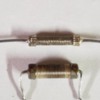First let me say my knowledge on electronics is less than minimal. A little back story. 5 years ago I had a Lionel BNSF #18291 and I absolutely hated the way it smoked or more accurately didn't. Here on the forum someone posted they had installed a 16 ohm MTH resistor and it smoked like crazy. I did the same with mine and liked the result.
Those who know much more about this, GRJ in particular, advised against this as going from a stock 27 ohm to the 16 ohm could potentially damage the triac and RL2C. (I don't know what either of those are) Anyway, it was suggested that a 20 ohm resistor was a safe bet not to burn up the electronics.
I ordered some 20 ohm resistors from Digi-Key and they ended up being 22 ohm. I installed one in my ABA, left the second A stock and there is barely a difference between the two.
Would going to a 20 ohm really make a difference from the 22 ohm?
BTW - I've already removed the sock and opened the intake hole to a 1/4". Using an old ZW for power.
I still have one 16 ohm MTH resistor in my tool box. Tempted...





